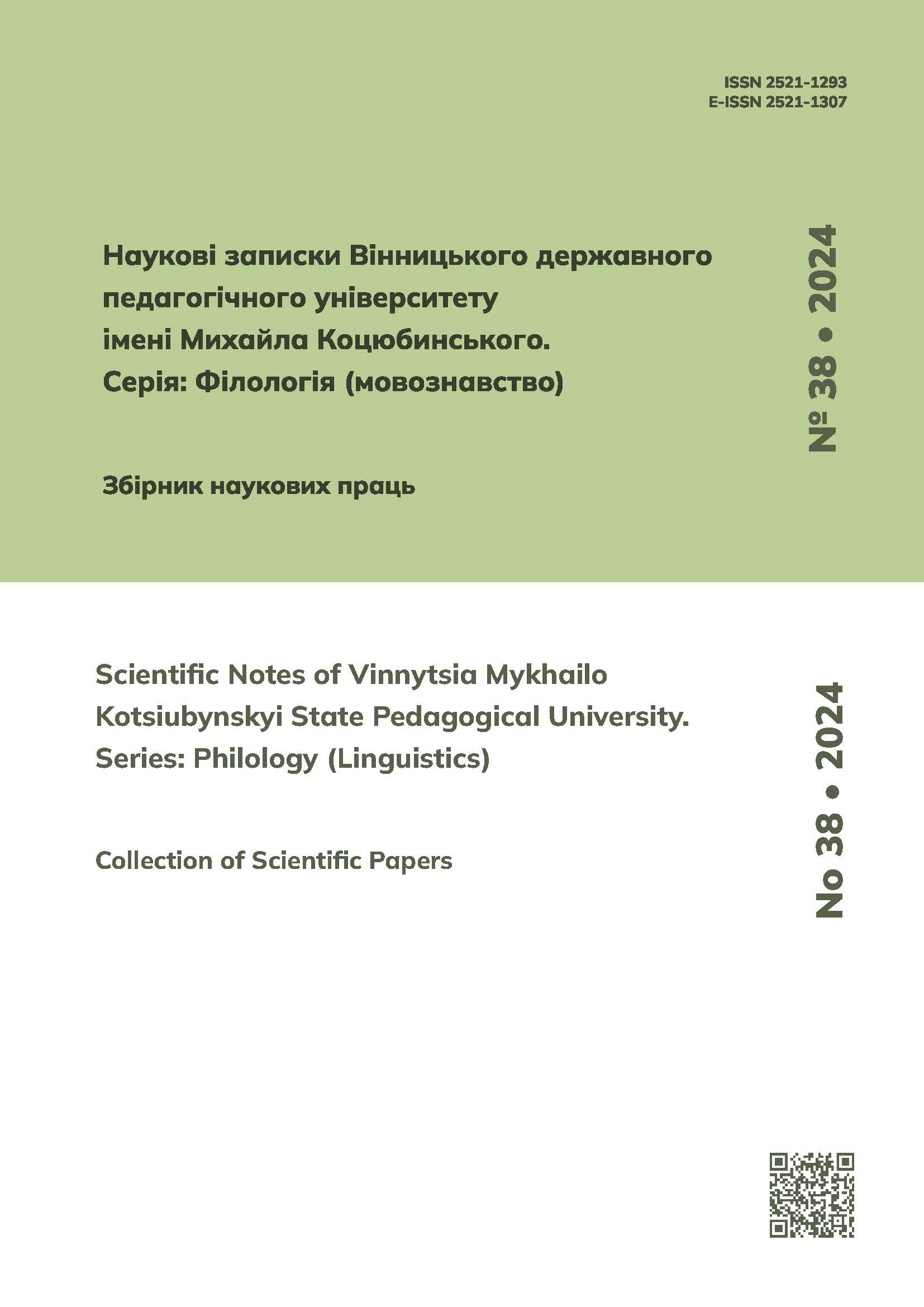Associative images of the media and the journalist in the language picture of the world of future teachers
https://doi.org/10.31652/2521-1307-2024-38-02Published 2024-08-13
Keywords
- associative image, associative field, media, journalist, language picture of the world, future teachers
Copyright (c) 2024 Nina Kukhar, Vitalii Handziuk

This work is licensed under a Creative Commons Attribution 4.0 International License.
How to Cite
Abstract
Media is an important component of the information society. The need to protect the territorial sovereignty of Ukraine after the full-scale invasion of the aggressor state, countering the hybrid war increased the importance of mass media. The object of our research is the associative image of the key concepts of the media industry - media and journalist, in particular, semantic shifts in these words, new connotative layering in the collective consciousness of Ukrainians. The purpose of the article is to analyze the associative images of the media and the journalist in the language picture of the world of higher education graduates of pedagogical specialties; on the material of a free associative experiment, associative fields of stimulus words were constructed, the most frequent, repeated and single associates were singled out and characterized. A free associative experiment was chosen as the main research method to collect reactions to stimulus words; descriptive and structural methods were used to analyze the associative field of the words media and journalist; statistical – for processing the obtained results, establishing the quantitative characteristics of the elements of associative fields. Results. The most frequent associations recorded because of the experiment are only partially correlated with the lexicographic characteristics of the stimulus words. Repeated reactions of future teachers represent semantic shifts in relevant concepts and connotational layering, which are relevant in the language consciousness of students of higher education. The associative fields of lexemes consist mainly of single reactions, a small number of which reflect the realities of martial law and well-known media figures. Such results of the associative experiment indicate the need to adjust and deepen the work with future teachers regarding the understanding of the information space, structure and content of the media. Originality. The relevance of our research is determined by the fact that the concepts of media and journalist are socially significant; they belong to the active composition of the lexical system, actualized in language practice by complex transformational processes in society. Among 262 reactions to the media stimulus word, 122 different associates were established. Modern lexicographic sources and industry reference publications equate the concepts of media, mass media. The associative image of the media in the language consciousness of future teachers primarily relates to information and channels and methods of its transmission, a significant part of the participants of the experiment expanded the concept. The associative field consists mainly of single reactions (79.5%). As a result of the free associative experiment, 286 word-reactions to the stimulus word journalist were obtained, of which 167 different associates, the most frequent reaction is news, single reactions make up 85.6% of the associative field. Repeated associates represent the image of a journalist in the language consciousness of future teachers, highlighting the conditions of professional activity and its results. The researched associative fields represent social stereotypes in the assessment of the media and the journalist.
Downloads
References
- Бігун, В. М. (2023). До проблеми визначення ключових понять у сфері медіа. Юридичний науковий електронний журнал, № 8, С. 266-270. https://doi.org/10.32782/2524-0374/2023-8/61 DOI: https://doi.org/10.32782/2524-0374/2023-8/61
- ВТСУМ – Великий тлумачний словник української мови. https://slovnyk.me/dict/vts/%D0%B0%D1%81%D0%BE%D1%86%D1%96%D0%B0%D1%86%D1%96%D1%8F
- Голованова, Н. В. (2017). Медіапростір як важливий чинник побудови інформаційного суспільства. Актуальні проблеми державного управління, № 1 (51), С. 27-34.
- Гонтар, М. О. (2011). Українська терміносистема журналістики: формування, структурна організація та функціонування : автореф. дис. … канд. філол. наук : 10.02.01 “українська мова” / Інститут української мови НАН України. Київ, 19 с.
- Дащенко, Н. (2020). Термінологія журналістики: питоме й запозичене. Вісник Національного університету «Львівська політехніка». Журналістські науки, Вип. 4, С.18-26. https://doi.org/10.23939/sjs2020.01.018 DOI: https://doi.org/10.23939/sjs2020.01.018
- Денисевич, О. В. (2011). Вільний асоціативний експеримент як засіб дослідження особливостей формування мовної картини світу. Психолінгвістика, Вип. 7, С. 92-97.
- Євграфова, А. (2015). Концептуальне поле журналістської терміносистеми у медійному контенті. Образ, Вип. 1(16), С. 9-14.
- Завальнюк, І. Я. (2023). Синтаксичні одиниці в мові вітчизняних масмедіа періоду російсько-української війни: оновлення змісту й структури. Наукові записки Вінницького державного педагогічного університету імені Михайла Коцюбинського. Серія: Філологія (мовознавство): зб. наук. праць, Вип. 37. С. 120-130. https://doi.org/10.31652/2521-1307-2023-37-120-130 DOI: https://doi.org/10.31652/2521-1307-2023-37-120-130
- Загородня, О. Ф. (2018). Асоціативні поля суспільно-політичної лексики в мовній картині світу українців (комп’ютерне опрацювання результатів психолінгвістичного експерименту) : дис. …кандидата. філол. наук: 10.02.21, Київ, 256 с.
- Закон – Закон України «Про медіа». https://zakon.rada.gov.ua/laws/show/2849-20/print
- Конах, В. К. (2015). Виникнення та еволюція поняття «медіа-простір» в науковій думці. Вісник Дніпропетровського університету, № 2, С. 112-129.
- Мартінек, С. (2011). Емпіричні й експериментальні методи у сучасній сучасній когнітивній лінгвістиці. Вісник Львівського університету. Серія філологічна, Вип. 52, С. 25-32. https://doi.org/10.30970/vpl.2011
- Недашківська, Т. Є. (2011). Семантична конструкція асоціативного поля (на матеріалі асоціативного експерименту). Психолінгвістика, Вип. 7, С. 126-134.
- Орлова, Н. В. (2018). Умови формування українського журналістикознавства та його наукової мови. Обрії друкарства, № 1 (6), С. 141-150.
- Селезньова, О. М. (2022). Термін «медіа-простір»: теоретичний підхід. Науковий вісник Ужгородського Національного Університету. Серія ПРАВО, Вип. 70, С. 359-363. https://doi.org/10.24144/2307-3322.2022.70.57 DOI: https://doi.org/10.24144/2307-3322.2022.70.57
- CЖ 2007 – Словник журналіста: терміни, мас-медіа, постаті / М-во освіти і науки України, Ужгород. нац. ун-т; [авт.-уклад.. : Ю. М.Бідзіля (відп. ред.) та ін.). Ужгород, 220 с.
- CУМ 20 – Словник української мови: в 20 томах.
- Шевченко, Л. І., Дергач, Д. В. & Сизонов, Д. Ю. (2014). Медіалінгвістика : словник термінів і понять / за ред. Л. І. Шевченко. Вид. 2-ге, випр. і доп., Київ, 380 с.





